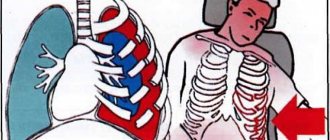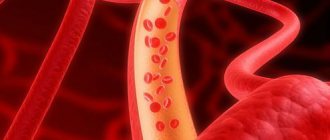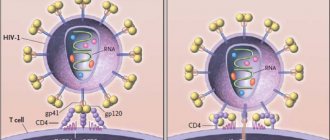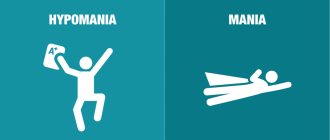Mental illnesses have similar symptoms, so they are often confused. For this reason, each of them requires differential diagnosis. However, split personality and schizophrenia have a slightly different fate. They are not just confused, but identified, taking them for the same disorder. In fact, these are two completely different diseases. Let's look at both to understand what the difference is between them and whether there are any similarities.
In this article
- Reason for confusion
- Dissociative identity disorder
- Causes
- Symptoms
- ICD-10 position
- Treatment
- About schizophrenia
- Conclusion
Reason for confusion
First, let's try to figure out why two different diseases began to be perceived as one. This is mainly due to the etymology of the word “schizophrenia”. From Greek it is literally translated as “to split” or “split” the “mind”, “thinking” or “thought”. This causes confusion among people who do not understand medicine and psychiatry.
But for an experienced doctor, differentiating these diagnoses is not so difficult. In short, with a split personality, it is as if a person has several people in one body. In schizophrenia there is no such split or split; the patient simply inadequately evaluates himself and the surrounding reality. The differences between these diseases will be more obvious if you look at their symptoms. Let's start with split personality.
Dissociative identity disorder
Multiple personality disorder is the common name for the mental illness “dissociative identity disorder.” The phrase “multiple personality disorder” is also sometimes used, in which a split personality occurs, resulting in the impression that several people live in one body. Switching from one personality to another occurs periodically. Moreover, each of them can be strikingly different from the first in such parameters as gender, age, education, profession, etc. After switching, one person may not remember what the other, replacing her, did.
This disease is very rare. It is included in the International Classification of Diseases, but not all countries agree to recognize it as a pathology. Disputes about its origin have been going on for centuries, but scientists have not come to a common denominator.
For the first time, dissociative disorder, or more precisely, a description of the condition that we today call identity disorder, is found in the works of Paracelsus. He described a woman who complained that sometimes someone robs her. Observations showed that she spends her own money, she just doesn’t remember it after shopping, since she does not consciously participate in the process.
Split personality is rare, but there is very high interest in the disease, including from people who are not related to medicine. This is due to the promotion of this topic in literature and cinema. One of the most famous patients with a similar diagnosis is Billy Milligan. 24 personalities coexisted in his body at once, 10 of which were the main ones.
Some experts believe that psychiatrists artificially increase interest in the topic in order to attract new clients and make money. What raises doubts is that people with this disorder often have a criminal history. When it comes to sanity, it is more profitable for them to be “crazy” than ordinary criminals, who can be imprisoned for life or even sentenced to death. The same Milligan was accused of thefts, robberies and rapes, for which he could pay with freedom or life.
In 1981, Daniel Keyes's novel The Many Minds of Billy Milligan was published, which became a bestseller and was translated into 14 languages.
However, most scientists still believe that dissociative identity disorder does occur and is a very complex mental illness that leads to a split personality.
Publications in the media
The clinical picture of dissociative and conversion disorders is manifested by somatic and mental symptoms. Somatic symptoms (often resembling a neurological disease) are characterized by a sudden and temporary change or loss of some bodily function as a result of psychological conflict (eg, psychogenic paralysis). Psychiatric symptoms are also closely related to psychological conflict and are characterized by sudden onset and reversibility.
Conversion in this case means the replacement (conversion) of anxiety with somatic symptoms, which often resemble a neurological disease (for example, psychogenic paralysis). Dissociation means the origin of symptoms from insufficient interaction between various mental functions and is manifested by symptoms of mental disorders (for example, psychogenic amnesia). An alternative name for this group of neurotic disorders is hysteria. The term “hysteria” is excluded from the American classification and ICD-10 as “compromising” and replaced by dissociation, conversion, histrionic personality disorder. However, this term is widely used by domestic psychiatrists. In the American DSM-IV classification, the terms dissociative and conversion have different meanings: the concept of conversion disorder is used to define those psychologically determined disorders that are manifested by somatic symptoms; while the concept of dissociative disorders refers to disorders that are manifested by psychological symptoms (eg, amnesia). In ICD-10, the terms “dissociative” and “conversion” disorders are identical.
CLINICAL PICTURE Dissociative (conversion) disorders are manifested primarily by symptoms of somatic and mental disorders caused by unconscious psychological mechanisms. The physical symptoms of this disorder are often similar to those of neurological diseases. Psychiatric symptoms can easily be mistaken for another mental disorder, such as dissociative stupor, which is also seen in depression and schizophrenia. Dissociative (conversion) disorders are not caused by somatic, neurological diseases, exposure to a psychoactive substance, or are not part of another mental disorder. The exclusion of somatic illness and other mental disorders is the main condition for diagnosing dissociative (conversion) disorders. There are two main problems in diagnosing these disorders . 1. At the initial stage of the disease, it is almost impossible to completely exclude somatic pathology that can cause dissociative (conversion) symptoms. Long-term observation of the patient and numerous diagnostic procedures (for example, MRI to rule out a brain tumor) are often necessary to make this diagnosis. In all doubtful cases, it is better to make a preliminary diagnosis of dissociative (conversion) disorder so as not to miss a serious somatic illness. 2. In many cases, it is difficult to determine whether the symptoms of a disorder are unconscious, or conscious and intentional (deliberate reproduction of symptoms in psychiatry is called malingering). In most cases, simulation is observed among those under investigation, prison inmates, conscripts, and also during conscription into the army. Patients with dissociative (conversion) disorder often consciously and deliberately exaggerate the unconscious symptoms of their illness. However, the diagnosis of this disorder assumes the existence of an unconscious component in the origin of symptoms.
Main clinical features • Dissociative (conversion) symptoms are not inherently intentional and premeditated, however, they are formed under the influence of the patient's idea of how the physical illness should manifest itself. As stated above, patients with dissociative (conversion) disorder often consciously and intentionally exaggerate their symptoms, but the disease is always based on unconscious and unintentional mental mechanisms. Patients with this disorder are not aware of the psychological basis behind their disorders, so they cannot control them voluntarily. In addition, it is quite obvious that dissociative (conversion) symptoms are an expression of emotional conflict, i.e. symptoms tend to develop in close association with psychological stress and often appear suddenly. • Absence of an organic etiological factor. The presence in the present or past of true neurological disorders or systemic diseases affecting the central nervous system is noted in 40% of patients with dissociative (conversion) disorder. Dissociative and conversion symptoms are sometimes difficult to distinguish from a somatic or neurological disease, which is especially true for patients who are well informed about the clinical picture and course of these diseases. But during a medical examination and examination of the patient, no obvious somatic or neurological disorders are revealed. It should be remembered that the diagnosis of dissociative (conversion) disorder is established only in the absence of physical or neurological disorders or in the absence of an etiological connection with these disorders. • Discrepancy between the clinical picture of dissociative (conversion) disorder and the clinical picture of similar somatic and neurological diseases. Dissociative (conversion) manifestations do not correspond to the symptoms of true neurological disorders, reflecting patients' naive ideas about anatomical innervation (for example, characteristic anesthesia of a limb; hemianesthesia with a sensitivity border passing exactly along the midline). This discrepancy is extremely important when clarifying the diagnosis. • Identification. Patients often unconsciously copy symptomatic manifestations that they observe in those around them, who are extremely significant for patients, for example, parents. In this way, patients seem to identify themselves with these people. Typical cases are when, for example, after the death of a father, an adult daughter develops dissociative paralysis, similar in clinical picture to that observed in the father before his death. • The primary benefit is that through the processes of dissociation and conversion, the patient subconsciously manages to avoid internal psychological conflicts; for example, with dissociative amnesia, the most unpleasant events disappear from the patient’s memory. • Secondary (social) benefit is that patients receive significant benefits as a result of their illness. Patients manage to avoid obligatory and difficult everyday situations because everything is forgiven to them; from others they receive help, support and attention that they would not have received without this; Patients, using their condition, can manipulate the feelings of other people. For example, dissociative paralysis helps a patient refuse unwanted care for an elderly relative. The patient usually lacks adequate awareness of secondary gain. Despite the nature of secondary benefit for dissociative and conversion disorders, it cannot be used in making a diagnosis.
Types of dissociative (conversion) disorder There are motor, sensory dissociative disorders and dissociative disorders with mental symptoms. • Movement disorders in dissociative (conversion) disorder include stupor, paralysis, gait disturbances, tremors and tics, aphonia and mutism, convulsions •• Dissociative stupor. The patient's behavior meets the criteria for stupor: voluntary movements and reactions to external stimuli (for example, light, noise, touch) are sharply reduced or absent. The patient is motionless for a long time, there is no speech and spontaneous and purposeful movements •• Dissociative paralysis is manifested in the inability to move any part of the body. Paralysis is caused by the simultaneous contraction of the flexor and extensor muscles (which are not paralyzed). The paralysis may involve one, two, or all four limbs, although the distribution of the lesion does not correspond to the innervation. Reflexes are not changed, there are no pathological reflexes; fasciculations, signs of muscle atrophy, changes in tone; no pathological changes are detected on the electromyogram •• Dissociative gait disorders. The gait is uncoordinated, ataxic, staggering and is accompanied by pronounced, irregular, jerking movements of the body, as well as erratic movements and swinging of the arms. Patients with dissociative gait disorders rarely fall, and when they do fall, they are usually not injured. Gait disturbances intensify when others pay attention to the patient •• Dissociative tremor is often severe and spreads to the entire limb. Dissociative tremor increases when attention is drawn to the patient. In dissociative disorder, dissociative tics are also observed. If a patient develops tremors and tics, it is necessary to exclude a neurological disease, because choreoathetoid movements of organic etiology can easily be mistaken for psychogenic symptoms •• Dissociative aphonia and mutism are not accompanied by diseases of the oral cavity or vocal cords •• Dissociative seizures must be differentiated from true epileptic seizures. With dissociative seizures, patients do not lose consciousness during the attack and retain memory of the events of this period; Stereotypical movements are not typical. Patients with dissociative seizures rarely hit their head when falling; convulsive movements are theatrical and always occur in the presence of other persons; with dissociative convulsions, cyanosis, involuntary urination and defecation, and tongue biting are not observed. In most cases, there is no paroxysmal activity on the EEG (it must be taken into account that 10–15% of the adult population exhibit abnormalities on the EEG). • Sensory dissociative disorders include hyperesthesia, paresthesia, anesthesia, blindness, deafness, and tunnel vision. The main differences between these disorders and organic diseases are that their prevalence does not correspond to innervation, the severity of these disorders is variable, the symptoms of the disorder can decrease with suggestion and self-hypnosis •• Anesthesia, paresthesia and hyperesthesia in dissociative (conversion) disorder do not correspond to innervation; symptoms are more often noted in the extremities. Paresthesia and hyperesthesia are described by patients, as a rule, as a feeling of pain or burning. For example, you can observe characteristic paresthesia of the extremities of the “stockings” and “socks” type; hemianesthesia with the border of sensitivity passing exactly along the midline •• Dissociative deafness, blindness and tunnel vision. These symptoms may be unilateral or bilateral. However, neurological examination reveals intact sensory pathways. With conversion blindness, for example, patients can move without assistance, and the pupils respond well to light. • Dissociative disorders with mental symptoms •• Dissociative amnesia (psychogenic amnesia) is a sudden loss of memory in a patient caused by stress or a traumatic event. Under the influence of a psychotraumatic situation, everything connected with it “falls out”, is “repressed” from memory. Sometimes the patient temporarily forgets not only some episode or individual events, but his entire life, down to his own first and last name. The patient’s consciousness is not impaired, he is aware of memory loss, and the ability to assimilate new information is preserved. During an amnestic episode, the patient may appear disoriented, confused, wandering aimlessly, and may not recognize familiar faces. Sometimes, outwardly, the patient may maintain normal behavior and perform some daily activities satisfactorily. Amnesia can bring the patient both primary (for example, loss of memory of the death of loved ones) and secondary benefits (for example, the removal of an amnesiac soldier from a combat zone). Dissociative amnesias are usually short-lived and end with complete restoration of memory. The disorder is usually observed during war or natural disaster, more often in young women •• Dissociative fugue (psychogenic flight response, dissociative flight response) is characterized by a person unexpectedly taking a trip or even traveling in a state corresponding to dissociative amnesia. Unlike psychogenic amnesia, the patient during a fugue episode is not aware of the memory disorder and does not appear disoriented. The patient may consider himself a completely different person and do a completely different job. The duration of a fugue is usually several hours/days. Rare cases can drag on for several months, during which sometimes the patient manages to travel thousands of kilometers. The end of the episode, like the beginning, occurs suddenly, often at the exit from a night's sleep. Characteristic is the subsequent partial or complete loss of memory of one's past, in many cases without awareness of this loss •• Dissociative stupor (hysterical stupor, psychogenic stupor, pseudocatatonic stupor, emotional stupor) also has a psychogenic origin; manifests itself as severe psychomotor retardation, accompanied by mutism and severe affective stress. Facial expressions are expressive, reflecting affect (suffering, despair, anger). When reminded of psychological trauma, patients' pulse quickens, tears well up in their eyes, and their eyelids and wings of the nose tremble. Characterized by the preservation of normal muscle tone, breathing, and the ability to independently maintain an upright body position •• Ganser syndrome is a rare condition in which dissociative memory impairment is accompanied by psychogenic somatic symptoms, visual hallucinations and twilight stupefaction. The disorder is more often reported in men, especially among prisoners. With Ganser's syndrome, sometimes passing speech is observed - incorrect answers to simple questions (to the question “What is twice seven?” the patient answers “Fifteen”) •• Disorder in the form of multiple personality (dissociative identification disorder) - an extremely rare condition in which a person identifies with several personalities that seem to exist in him alone; each of them periodically dominates, determining his views, behavior and attitude towards himself as if other personalities were absent. Different personalities may have different physiological characteristics, such as needing different eyeglass prescriptions; There may be different responses to psychometric testing, for example different personalities may have different IQs. Individuals may be of different genders, ages, and nationalities, each usually having a different name or description. During the period of predominance of one of the personalities, the patient does not remember his original personality and is not aware of the existence of other personalities. There is a tendency for a sudden transition from the dominance of one personality to the dominance of another •• Dissociative disorder in the form of a trance. A disorder of consciousness with a significant decrease in the ability to respond to external stimuli. A trance state is observed in mediums during spiritualistic seances, in pilots during long flights due to the monotony of movement at high speeds and the monotony of visual impressions, which can lead to plane crashes. In children, such conditions can occur after physical abuse or trauma. Special states of possession are observed in a certain region or in a particular culture, for example, “amok” among the Malays (a sudden attack of rage followed by amnesia, during which the patient runs, destroying everything in his path, until he cripples or will kill himself), “piblokto” among the Eskimos (attacks of excitement followed by amnesia, during which patients scream, imitate animal sounds, and tear off their clothes).
Differential diagnosis In most cases, the greatest problems are caused by the exclusion of organic diseases of the central nervous system. For example, weakness is noted in myasthenia gravis, myopathies and multiple sclerosis. Optic neuritis may be mistaken for dissociative blindness. Symptoms and signs that do not correspond to the anatomical structures or known pathophysiological mechanisms of any diseases, and also vary from one assessment to another, are more likely to be due to a dissociative disorder than to a physical illness. Thus, in all cases it is necessary to conduct a thorough somatic and neurological examination of the patient. Symptoms. which disappear under the influence of hypnosis, suggestion, or intravenous administration of barbamyl, are also most likely psychogenic. When conducting a differential diagnosis of dissociative (conversion) disorder, it is necessary to take into account the following clinical features. • Age of onset of disease. Dissociative disorders are most often first diagnosed before the age of 40. • The appearance of symptoms is provoked by stressful situations. If such situations are absent, then the diagnosis of the disorder is doubtful. However, stressful situations in themselves do not prove a diagnosis of dissociative disorder, because they often precede somatic diseases. • Secondary benefit (see above). In the absence of secondary gain, the diagnosis of dissociative disorder should be reconsidered. However, the presence of secondary gain alone does not prove a diagnosis of the disorder, because Sometimes patients with physical illnesses use their condition to achieve some goals (for example, disability benefits).
TREATMENT First of all, it is necessary, if possible, to eliminate traumatic circumstances or mitigate their impact. Sometimes a change of environment has a positive effect. The main place in the treatment of dissociative disorders is given to psychotherapy, in particular rational therapy. It is necessary to delicately explain to the patient that the symptoms are not caused by a physical illness, but by psychological reasons, for example, you can tell the patient that everything is fine, that all painful symptoms will pass over time and that he is indicated for treatment using psychological methods. If you tell such patients that all their complaints are a figment of imagination, this does not lead to improvement, but to deterioration. Repeated persistent and purposeful conversations with the patient help him develop the correct attitude towards the causes of the disease. Psychological treatment . The method of choice is psychoanalytic psychotherapy. In some cases, hypnosis and behavioral psychotherapy are successful. An important condition for successful treatment is studying the patient’s social situation in order to eliminate secondary benefits from the disease. Drug therapy plays a minor role in the treatment of dissociative disorders, except in cases where conversion symptoms occur secondary to depressive disorders. For severe anxiety, tranquilizers are recommended, for example diazepam 2–10 mg orally 2–4 times a day (long-term treatment is not indicated due to the high risk of developing addiction). For depressive conditions, antidepressants are prescribed, for example fluoxetine 20–40 mg/day. Lead tactics. Most patients improve with treatment. If there is no effect of therapy, it is necessary to once again exclude the possibility of a somatic disease. Shorter, more directive methods of psychotherapy are used to treat dissociative disorders. The more time such patients spend in the role of patients, the worse they respond to therapy. The prognosis is usually favorable • In most cases, conversion symptoms are short-lived, begin suddenly and end just as suddenly • Long-term dissociative disorders, combined with secondary gain, are difficult to treat • Dissociative amnesia - sudden end of the disorder, few relapses • Dissociative fugue - usually a short-term disorder, recovery occurs spontaneously and quickly, relapses are rare • Dissociative identity disorder is the most severe of the dissociative disorders with the greatest likelihood of chronicity. Patients with dissociative identity disorders throughout their lives, while remaining outwardly absolutely healthy, may suffer from depressive conditions. Synonyms • Hysterical neurosis • Conversion disorder
ICD-10 • F44 Dissociative [conversion] disorders • F06.5 Organic dissociative disorder
Causes
In psychology and psychiatry, the concept of “dissociation” is used to describe a defense mechanism activated by the psyche in a stressful or difficult situation for a person that he does not want to experience personally. He seems to abstract himself and observe himself from the outside, as if all this “is not happening to him.”
The tendency to such behavior can act as one of the reasons for the development of dissociative identity disorder. Dissociation can be provoked by violence, despotic upbringing, psychological or physical trauma, etc.
Genetic factors can also play a large role when the patient has or had close relatives with similar mental illnesses. In general, a child is born without a coherent identity. His personality will have to be formed in a cultural environment.
If a child is abused or left to his own devices and does not receive proper education, he can displace negativity from his mind. Hypothetically, this could subsequently lead to identity disorder.
It should be understood that versions of the causes of this mental illness are only assumptions. Science does not know exactly how childhood memories are formed and how exactly they later affect a person’s life. The same situation can affect two children differently.
Thus, a child who sees his father systematically beating his mother is also likely to start beating women. However, it is possible that he will become their ardent defender. It is almost impossible to accurately predict this. One way or another, people who were subjected to psychological, physical or sexual violence in childhood are at risk for many mental pathologies. As they develop, the psychiatrist necessarily studies the patient’s biography.
The fact of violence is registered in 85% of adults and 95% of children with dual personality disorder.
Psychedelics can also lead to split personality. In the 50s last century, scientists tried to figure out the mechanism of development of schizophrenia by studying psychedelic drugs. Some of the volunteers who took part in the experiment had a split personality. Moreover, it was not possible to return people to their original, healthy state.
Brief description of the disease
Pathology is difficult to classify and diagnose, which is primarily due to the characteristics of a person’s personality. According to psychotherapists, the personality of an individual patient includes many traits determined by his own life experience, memory, character, characteristics of upbringing, and abilities. Depending on the circumstances, these factors, roughly speaking, “regroup” in the mind in a completely unpredictable way, which gives rise to a new personality.
At present, there are no accurate statistics on incidence, especially since in Russia people began to talk about such a disorder only recently. Only a few specialized clinics, including the Leto mental health center, deal with such pathology. But it is known that pathology in 75–90% of cases manifests itself in childhood and adolescence. The problem is that loved ones may not immediately notice such a state, mistaking it for another child’s game, and, moreover, take an active part in it.
It is believed that genetic predisposition also plays an important role in the formation of this type of dissociative disorder - signs of the disorder are often identified in direct relatives. Approximately 25% of cases have concomitant epilepsy, and half have additional symptoms of borderline disorders.
Symptoms
There can be many signs of dissociative identity disorder. Scientists have systematized all forms of manifestation of the disease and identified key symptoms. Among them:
- Dissociative fugue, or dissociative flight reaction. In this state, a person looks healthy, but he develops features that are unusual for him. He may suddenly leave or leave work, answer to different names, and look lost. As a rule, this passes quickly, but minor memory lapses are possible.
- Dissociative amnesia. Usually, memory disappears for individual events that traumatize the psyche. The person understands this and tries to remember something, but he fails. At the same time, he assimilates new information well.
- Dissociative identity disorder. This is a form of direct split personality, when it splits into several persons, each of which has its own name, character and even nationality. The main personality does not control the transition from one character to another. Subsequently, a person cannot remember what he did and how he ended up in this or that place.
- Depersonalization disorder. The patient feels as if he is observing his body from the outside. The perception of the world changes, it becomes colorless. The feeling in time and space is lost. A person suffers from anxiety and depression. These signs are similar to the symptoms of some forms of schizophrenia.
- Trance. In this state, the patient does not respond to external stimuli. Children tend to behave this way in response to violence or as a result of trauma.
- Ganser's syndrome (speech). A person deliberately gives incorrect answers to the simplest questions, feigns a serious mental illness, performs actions in the reverse order, for example, lights a match with the wrong side. The syndrome is often detected in male criminals. In such situations, it is difficult to determine whether a person is really sick or is trying to pretend to be sick. After recovery from the attack, amnesia sets in.
Any of these signs is a reason to consult a psychotherapist. If this is not done, the disease will progress, which is often accompanied by:
- suicide attempts;
- severe headaches;
- self-harm;
- problems with eating;
- drug addiction and alcoholism;
- deviant behavior, etc.
There are other possible consequences that the patient may not remember. If you believe the biography of Billy Milligan, then sexual crimes, that is, violence against women, were committed by a lesbian girl (one of his personalities) who sought physical intimacy with girls.
How to make a diagnosis
When diagnosing dissociative identity disorder, a specialist must immediately rule out organic brain damage; for this, magnetic resonance imaging, computed tomography, and electroencephalography are performed. It is necessary to exclude:
- delirium (impaired consciousness);
- mental retardation;
- amnesia after surgery, trauma, concussion;
- somatoform (psychosomatic) disorders;
- dementia;
- temporal lobe epilepsy;
- schizophrenia;
- amnestic syndrome;
- bipolar disorder;
- influence of psychotropic substances and alcohol;
- borderline personality disorder;
- normal simulation;
- neoplasms of various nature.
Dissociative disorder is confirmed by the presence of several personality states that differ from each other and have their own pattern of behavior, perception of the environment, etc. At least two of these identities alternately receive full control of the patient. The patient cannot remember any personal information and this is not at all forgetfulness.
If the patient is a child, then one cannot speak of a diagnosis of “multiple personality disorder” if he talks about imaginary friends or is talking about a fantasy game. The latter also applies to adults, since split personality in this case is a feature of the psyche to react in this way to certain life situations.
To make a diagnosis, patient observations and special questionnaires are used. Hypnosis or the introduction of the so-called “truth serum” - amytal-caffeine disinhibition - can be used. Both of these make it possible to immerse a person in a euphorically relaxed state in which his hidden subcortical structures are “revealed.” He tells about himself what he deliberately hid or what was inaccessible due to psychogenic amnesia.
ICD-10 position
In the International Classification of Diseases, Tenth Revision (ICD-10), multiple personality disorder is included in category F44. To make such a diagnosis, it is necessary to identify four signs in the patient:
- The presence of two or more personalities, and only one should be present at a given time.
- Each personality has its own memory, preferences and behavioral characteristics; at times one of them seizes control of consciousness.
- The patient cannot remember information important to the main personality. At the same time, memory lapses exceed ordinary forgetfulness in scale.
- Symptoms are not associated with organic mental disorders, such as epilepsy and substance use.
The number of individuals can exceed a hundred. Their number has been growing over the years. They arise unconsciously. Most likely, the brain creates them to make it easier to cope with various situations. So, at the very beginning of treatment, the doctor can identify 2-4 personalities in the patient, and as communication progresses, another 10-12. Each has its own mannerisms, gestures and even handwriting. Often they don't know that they are not the only ones in a person's head.
Each person can have a different IQ, and the spread can be quite significant - from 80 for one to 140 for another.
Such patients are very rare, which is why specialists have different attitudes towards this disease. But the world of art and commerce often exploits this topic, as it attracts the interest of the public.
Causes
By now, experts agree that this is a form of post-traumatic stress. A combination of the following factors predisposes to the development of the disease:
Tendency to dissociation, which is associated with pathological processes in the temporal lobe of the brain. This theory is supported by a history of attacks of temporal lobe epilepsy.- Severe psychological trauma, in particular, sexual, physical or psychological abuse in childhood (such episodes are present in 80–98% of patients).
- Influence of external factors.
It is believed that such a violation is the result of a kind of autohypnosis, self-defense, a subconscious desire to avoid extremely difficult memories.
Treatment
Treatment of dissociative identity disorder is carried out with the help of psychotherapy - cognitive, family, behavioral, etc. All of them are aimed at merging all personalities into one full-fledged identity. The psychiatrist also tries to identify the nature of the internal conflict, to work through situations that turned out to be traumatic for a person and became the reason for the creation of many personalities.
Drug therapy for such diseases does not help. There are no specific medications designed to treat it. The doctor can only prescribe antidepressants if the patient is worried about anxiety and depression. But the main treatment is aimed at ensuring the harmonious coexistence of different personalities. This allows you to protect both the patient and those around him.
About schizophrenia
Schizophrenia is an endogenous polymorphic mental illness that affects thinking. It does not lead to a split personality. Even if the patient considers himself Napoleon, no split occurs. In this case, we are talking about the disintegration of personal characteristics, but within the framework of one identity. As a result, a person can completely lose touch with reality and remain inside his own fantasies.
The causes of schizophrenia are unknown. Like most mental disorders, it is genetically determined. It can be triggered by various factors, including psychological trauma, as with split personality.
Schizophrenia manifests itself in different ways and develops some form in about 1 in 100 people.
The symptoms of psychopathology depend on the phase. When the psyche is active, symptoms of an attack or exacerbation are observed:
- Delusional ideas (delusions of grandeur, delusions of jealousy, invention, reformism, etc.).
- Hallucinations (often voices, but can be visual, tactile or even olfactory).
- Catatonic syndrome (excitement, in which a person makes strange, similar movements; or stupor, when the patient freezes for a long time in an unnatural position).
In the negative phase, the patient suffers from apathy, depression, lack of will and other symptoms that indicate the passivity of the mental apparatus.
These signs can also be observed in people with split personality. However, delusions and hallucinations are extremely rare. Catatonia is also not typical for this disorder.
Treatment of schizophrenia is carried out using psychotherapeutic methods and medications. Among the latter are various types of antipsychotic drugs. Some of them increase dopamine levels, while others, on the contrary, decrease them. This allows you to cope with depression or delusions and hallucinations, respectively.









